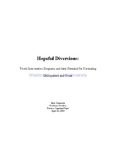| dc.rights.license | In Copyright | en_US |
| dc.creator | Vilenchik, Maxim | |
| dc.date.accessioned | 2013-12-10T15:55:21Z | |
| dc.date.available | 2013-12-10T15:55:21Z | |
| dc.date.created | 2008 | |
| dc.identifier | WLURG38_Vilenchik_POV_2008_wm | |
| dc.identifier.uri | http://hdl.handle.net/11021/24228 | |
| dc.description | Maxim Vilenchik is a member of the Class of 2008 of Washington and Lee University. | en_US |
| dc.description | Capstone; [FULL-TEXT FREELY AVAILABLE ONLINE] | en_US |
| dc.description.abstract | Given the seriousness of the problem, it is surprising that most of the money and effort devoted to addressing it has been restricted to a narrow range of remedies with much of the attention on the incarceration of persons who have already committed crimes. Significantly less consideration has been given to diverting individuals from committing crimes in the first place. This paper initially examines some of the theories on the causes of crime, and why U.S. crime tends to be most prevalent in disadvantaged urban neighborhoods (Reid, 2003). Then I attempt to determine whether some alternative crime remedies would be effective in high-risk communities. My research question seeks to explore the effects of three types social interventions directed toward high-risk youths: early childhood development programs, formal after-school programs, and community recreation centers. I review important findings from previous literature and provide case studies of specific intervention programs which are already publicly implemented and can be replicated and expanded to other locations. Crime in disadvantaged urban neighborhoods is a complex phenomenon that stems from many conditions, including economic, psychological, and environmental factors, which are often interrelated in these communities. Social intervention programs for at-risk youth that are designed to divert some of the risk-factors (discussed in the following section) for crime may have the potential to significantly reduce delinquency and crime. This paper strives to shed more light on this connection and its findings may inspire further research and better public policies. [From Introduction] | en_US |
| dc.description.statementofresponsibility | Max Vilenchik | |
| dc.format.extent | 33 pages | en_US |
| dc.language.iso | en_US | en_US |
| dc.rights | This material is made available for use in research, teaching, and private study, pursuant to U.S. Copyright law. The user assumes full responsibility for any use of the materials, including but not limited to, infringement of copyright and publication rights of reproduced materials. Any materials used should be fully credited with the source. | en_US |
| dc.rights.uri | http://rightsstatements.org/vocab/InC/1.0/ | en_US |
| dc.subject.other | Washington and Lee University, Shepherd Poverty Program | en_US |
| dc.title | Hopeful Diversions: Youth Intervention Programs and their Potential for Preventing Delinquency and Crime | en_US |
| dc.type | Text | en_US |
| dcterms.isPartOf | RG38 - Student Papers | |
| dc.rights.holder | Vilenchik, Maxim | |
| dc.subject.fast | At-risk youth -- Services for | en_US |
| dc.subject.fast | Juvenile delinquency -- Prevention | en_US |
| dc.subject.fast | Education, Preschool -- Activity programs | en_US |
| dc.subject.fast | Perry Preschool Project (Ypsilanti, Mich.) | en_US |
| dc.subject.fast | Child-Parent Center Program (Chicago, Ill.) | en_US |
| dc.subject.fast | After-school programs | en_US |
| dc.subject.fast | Community centers | en_US |
| dc.subject.fast | Boys & Girls Clubs of America | en_US |
| dc.subject.fast | Intersectionality | en_US |
| local.department | Shepherd Poverty Program | en_US |
| local.scholarshiptype | Capstone | en_US |
